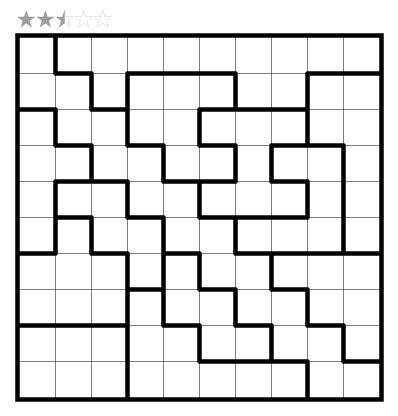LITS by Nate Perkins

or solve online (using our beta test of Penpa-Edit tools)
Theme: I’m Going Down
Author/Opus: This is the 2nd puzzle from guest contributor Nate Perkins.
Rules: Standard LITS rules.
Difficulty: 2.5 stars
Time Standards (highlight to view): Grandmaster = 1:30, Master = 3:30, Expert = 7:00
Solution: PDF; a solution video is also available here.
Note: Follow this link for more variations of LITS and this link for classic LITS. If you are new to this puzzle type, here are our easiest LITS to get started on. More LITS puzzles can be found in LOTS O’ LITS by Grant Fikes and Prasanna Seshadri, in The Art of Puzzles 2, and in our beginner-friendly collection Intro to GMPuzzles by Serkan Yürekli.

I find it hard to solve these on Penpa Edit because it requires the solution to be marked in black or dark grey, which makes it touch to see cell borders. Personally I use green and brown when using floodfill (green for “yes”, brown for “no”)
@Asher – I have been thinking to add another color for the answer check apart from DG(Dark Grey) and Black but haven’t concluded which one to add. I definitely don’t want to add more than 1 apart from what already exists as other colors are used as helper colors in many cases.
Do you think if I add “GR” (regular grey color, the option to the right side of “DG”) to the solution check will improve the visibility? I want to keep it greyscale to keep it color-blind-free.
A real head scratcher … succeeded after trial and error.
@Swaroop – I use green/brown because of the contrast (I do my puzzling at night with f.lux active, so my computer’s colors are muted), but I think regular grey would be good too.
@Asher S – Thanks for confirming. I will be adding GR/LG in the future update. Basically, then all 4 greyscale colors will be supported by an answer-check (DG, GR, LG, BL).
@Swaroop, another idea would be to enable something like “For automatic solution checking, the shaded cells must be marked in any single color.”
I imagine that would slow down checking a little bit, but not significantly (i.e. check if the solution grid matches the grid for any color, rather than the “gray/not gray” grid). There could also be a slight optimization to short-circuit for colors that are not used in the grid at all.
4:33 excellent puzzle!